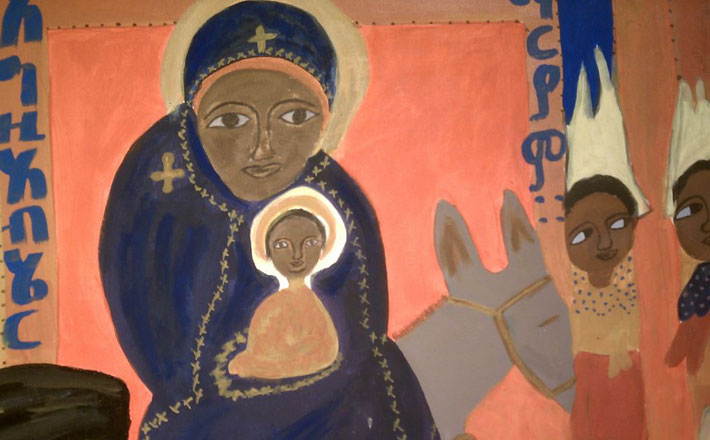Commentary on Luke 2:1-14 [15-20]
The story of the census, the angels, and the manger is so familiar that it may be a struggle to notice what it does not tell us.
The preacher may find significant clues to how this story feeds faith in what the story does not tell us. Taking in any oh-so-familiar scripture calls for a few mental and spiritual gymnastics to see and hear it anew. To avoid a rehash of what is already known, the preacher wants to dig deep enough to find what will help us shudder with love on this most holy night.
With each possible answer, each thread that pulls you to a new insight, keep asking Why is that?
- What prompted Caesar Augustus to order a census?
- Why is there no room at the inn?
- How far away from the manger are the shepherds?
- Do the sheep see and hear the angels?
- What is the “glory” of the Lord?
- What is it about the angels that terrifies the shepherds?
- How do the shepherds find the little family?
Even if we are still unable to gather in person in December 2020 because of the devastating virus, this story means to pull us together. Like the shepherds in the field, terrified at a strange reality that suddenly appears before them, this story beckons us to hasten to the new thing, marvel at a homeless little family, see God’s love for everyone because of this baby in the manger, and be transformed.
The context of this story is not unfamiliar to us: the power emanating from Caesar’s throne, the requirement to obey the law no matter what it is, the inability of the infrastructure to handle the crowds (the inn could never be big enough), and the exigencies of pregnancy despite the circumstances. Some physical realities are going to happen within us without regard to what is going on outside of us. A woman who has come to term will need a place to deliver her child.
And then there is the child: silent, lying in a feed trough, unable to help himself, certainly not an “influencer.” Jesus is just there, born into a world unaware of him except for some sheepherders (and possibly their sheep), in the same way a virus comes into our midst silently, invisibly. And yet Jesus comes to heal and teach, not to divide us. The virus has crept between us, made us sick and afraid. Every Christmas Eve is the time to tell the story, hear the angels, see the shepherds, ponder with Mary, and be filled with joy over the infinite mystery that God-with-us, Emmanu-el, is born, because it means to assure us that it is into our insecure and troubled live that Jesus comes again and again.
Christmas—the Nativity, the birth of Jesus of Nazareth—means to amaze us. Not only is the announcement of the birth celestial, but because of the manger’s lowliness its power is its contrast to the triumphant mythic terms that people had come to expect about Roman rulers. The Messiah is born not as an obvious king. We learn about this momentous event through shepherds with whom we can identify because, like us, they are ordinary workers. Along with the shepherds who are minding those for whom they have responsibilities (their sheep), God confronts us with a proclamation that is both terrifying and wondrous. That multitude of angels, the heavenly host, filled the sky and overwhelmed all sensibilities while also relieving the shepherds of their fear.
This story, at bottom, exemplifies the mystery of a world in which we have been called to move toward one another rather than build walls. We have been called to accept both our terror and our joy because all of it is known to God. We are rightfully awed by the prospect of promised peace and harmony because around us we do not see the path to that longed-for place. The vision has to come from outside our own sensibilities; it comes from angels who are messengers of the Author of creation.
One puzzle in this text, despite all the aspects of the story that elude our understanding, stands out as a continuing thorn: to whom is this child really born? The angels tell the shepherds that the Messiah is born “for all people.” The heavenly host says that peace on earth is for “those whom [God] favors.” Let this question invite both inclusivity and exclusivity in the way of all biblical ambiguity. Who is the savior saving? “To you is born this day…” How does the Holy Spirit transcend our closed-in hearts and minds? “Do not be afraid…”
The answers to our questions about this most holy birth are found in the story we hear on Christmas Eve whether we come to worship with families or alone or with friends, whether we are hungry because we come early before the feast or full because we come at midnight after much feasting. We come to hear the songs that take us back into the Christmases we have known throughout our lives, the tunes that remind us of our parents or the people who befriended us, the rituals of dressing up, opening presents, giving gifts, and gazing at brilliant decorations—or having had none of those things in our formative years while yearning for them.
We come for the savior who is in the manger. There, Jesus is swaddled in warmth, in the safety his parents provide. Because of Jesus’ newborn fragility, he is dependent on those who care for him. He becomes emblematic of us all—infant, young adult, middle aged, or elderly—who need the care of family and neighbor and to be swaddled by the love of God, whether or not we know it.


December 24, 2020